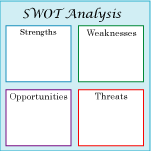SWOT Diagram Tips and Techniques
Department or Team SWOT
"Discover what they don’t teach you in business school, and learn how you can create a meaningful SWOT for your team or department"
The SWOT Diagram is a great technique to help you to develop your strategy, but how do you use the SWOT technique if you are not a corporate strategist? Read on to find out
SWOT Analysis Examples |Retail Industry | Timber Industry | Web Business |Department
A Departmental SWOT Diagram
There are a few differences between a SWOT analysis developed for a team or department and one that is developed for the whole business. One of the major differences is the possibility that your department may operate in an environment that is more competitive than your parent organization.
For example:
Imagine a parent company that is an electrical building products manufacturer with greater than 50% market share in its region, i.e. its core business it has only one real competitor.
Over the last few years your parent company has diversified and entered into the supply and installation of home security products. The home security products market has 25 recognized competitors all competing for market share.
You will find in your SWOT analysis that the parent company has placid competition and substantial barriers to entry for new suppliers, and as such it will develop policies, procedures and a decision-making hierarchy that reflect this market dominance.
In contrast, your SWOT will identify that the home security company has less barriers to entry and high price competition. However, it may be forced to comply with the parent companies policies, procedures and may even take on its culture, even though the home security business operates in a far more competitive environment.
In this scenario, the home security business will have a different SWOT diagram to its parent company, because it operates in a different market with different competitive forces, and one of it's weaknesses will be the parent companies control over policies, procedures and even culture.
Scroll down to look at some common scenarios to consider in your SWOT diagram
Common Scenarios |
SWOT Diagram Considerations |
You are a team leader in a large business. |
A SWOT does not really apply to your team, however you can look at your teams strengths and weaknesses. Where possible start by looking at your business units SWOT and select relevant items from it for your SWOT. Then complete an analysis of your team’s strengths and weaknesses. Ideally you will benchmark your team against your competitors, though you may only be able to compare with other teams in your work environment. You can add some of your business unit’s opportunities and threats if you like to make your SWOT diagram complete.
|
Your department produces a saleable product or service that is a not a core product or service. |
You can use your corporate analysis for your macro environment. However, because you operate in a different industry to your parent organization. you will need to review your industry environment. It is possible that you will identify a different competitive environment to that of your parent organization. Additional considerations On this site we maintain that opportunities and threats are external to your organization., however when completing a divisional or departmental SWOT you may need to consider an internal competitive force. Internal competition
You will also need to consider competitor size as a factor in your strengths and weaknesses. Whilst you might be a part of a big business you need to determine if this is a strength or weakness for you. Big businesses are often less responsive and have higher overhead recovery costs than small business. You could be slow to respond, as you are bound by your corporate processes, employment conditions and approval processes. And as you are non core your issues never seem to be a priority.
|
Your team produces something that could be outsourced. |
When completing your SWOT diagram you will need to consider who your competitors are, your competitors will be those who your work can be outsourced to. Again your organization. maybe competing in a different industry environment to your department and thus subject to different competitive forces. A frequent mistake is to assume your parent company will not outsource you, this may hold true until there is a change in their competitive forces. Some common examples of processes that are outsourced
|
Your team works on the core products or processes of the business |
Just complete a SWOT for your products or services. |
In summary
Your organization. may have a strategic analyst who maintains the corporate SWOT diagram. However, you may find that the nature of competition in your part of the business could be different to the nature of competition of your parent corporation.
So, you may have to complete an independent SWOT analysis that represents your departments competitive environment. If your organization. is in a more competitive environment, then your corporate policies could be a weakness.
And
At departmental level you might find that you also have internal competitor or at least competition internally for resources.
Thank you for reading our SWOT Diagram Tips and Techniques page for department or team SWOT, if you have not seen all of our SWOT Analysis examples, why not take five minutes to click through and review them now?
Retail Industry | Timber Industry | Web Business |Department
Return from our SWOT Diagram Tips and Techniques page to our SWOT home page



